Ancient Galicia: Exploring Spain’s Celtic North
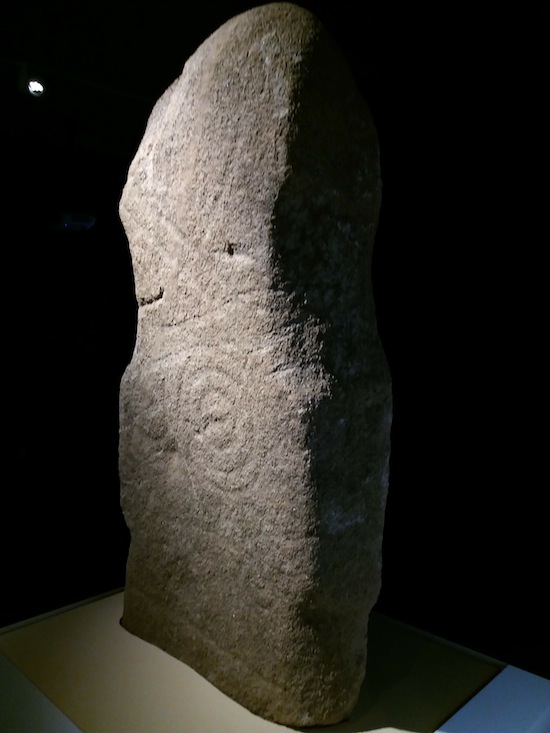
The Stele of Castrelo de Val, showing a shield and chariot.
This Bronze Age stele is similar to those found in Ireland,
Denmark, Sweden, and the Mediterranean.
When one thinks of Spain, one generally thinks of sun-soaked coastlines and arid stretches of plain, but Spain’s northern coast is a green, hilly region with a strong Celtic tradition. The westernmost region, just north of Portugal, is called Galicia. Here you’ll find cider instead of wine, bagpipes instead of castanets, and a rich archaeological heritage.
GALAICOS. Un pueblo entre dos mundos at the Museo Arqueológico Nacional in Madrid explores the ancient history of this region from the Bronze Age to the arrival of Christianity. It reveals a well-populated archaeological region that was connected to the Phoenician and Greek trade routes along the Atlantic coast to the tin mines in Britain. The exhibition shows some interesting examples of artifacts making their way along the trade route to Galicia from Italy, Greece, and North Africa.
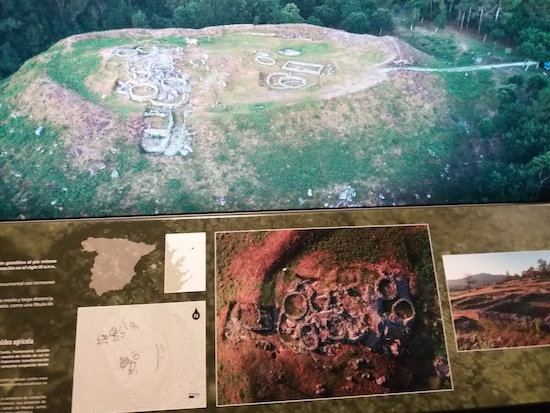
A typical dwelling in the Iron Age was the castro, a hilltop
fortified settlement. The castro of Castrolandín was founded in the 4th
century and had stone walls and a gate, plus densely packed houses.
These settlements dot the hilly landscape of Galicia. Finds of wine
amphorae and other Mediterranean goods are common at these sites
The fertile land and the resources offered by the sea meant that Galicia had a fairly dense population, concentrated in small, fortified villages. The region gets its name from the Roman name for the local tribes, the Gallaeci. The Romans first pushed into this region in 137 BC, coming up against an army of some 60,000 warriors. This must have been a coalition of different tribes who put aside their differences to face a common threat. They were not successful, however, and Roman military might emerged victorious. Resistance continued in the more remote regions until finally being stamped out in 19 BC.
This exhibition, while fascinating, covers a bit too large of a time period in too small of a space, so it ends up being more of a sampler than a thorough history. Luckily, the museum’s permanent exhibitions include large sections on Celtic Spain and Roman Spain.
Galaicos runs until February 3.
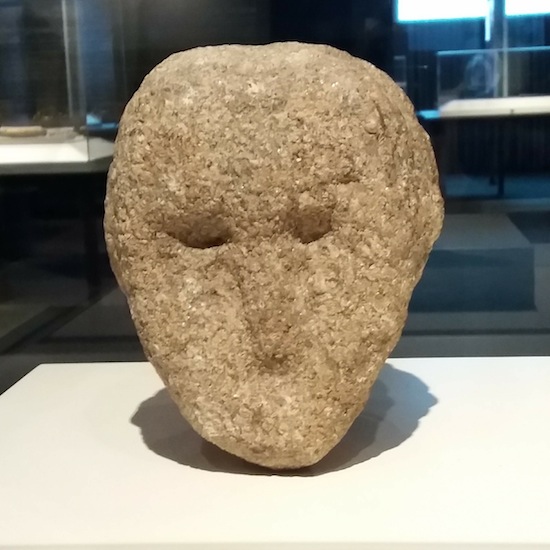
Stone Head, 2nd to 1st century BC
Photos copyright Sean McLachlan. More below!
Sean McLachlan is the author of the historical fantasy novel A Fine Likeness, set in Civil War Missouri, and several other titles. Find out more about him on his blog and Amazon author’s page. His latest book, Tangier Bank Heist, is a noir mystery set in the International Zone of Tangier in the 1950s.
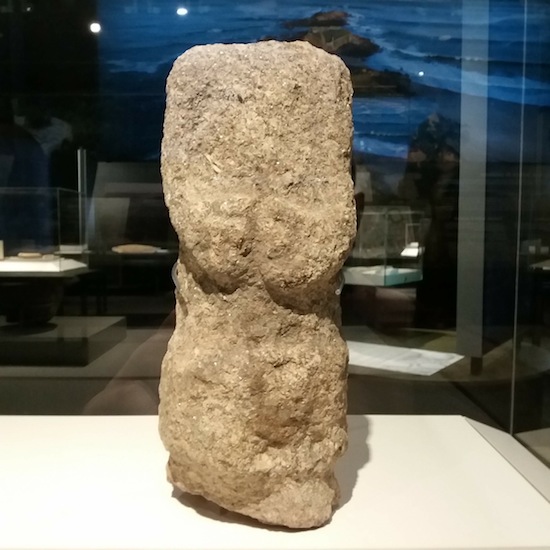
Anthropomorphic statue, 2nd to 1st century BC
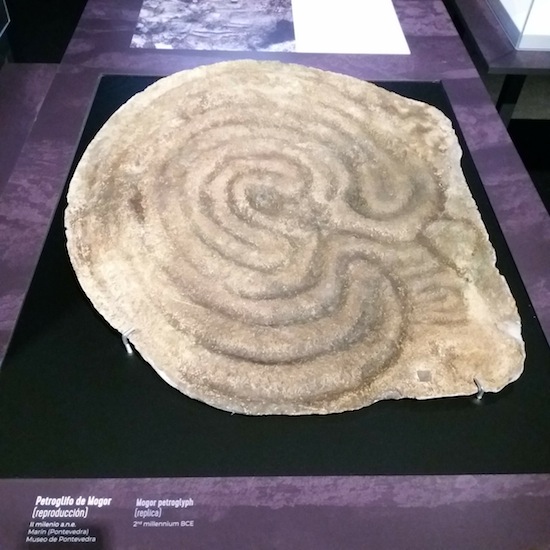
This labyrinth petroglyph from the 2nd millennium
BC shows an image common throughout Europe
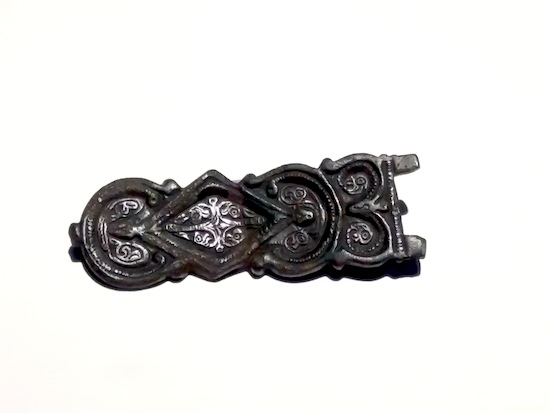
Bronze belt buckle, 6th-7th century AD
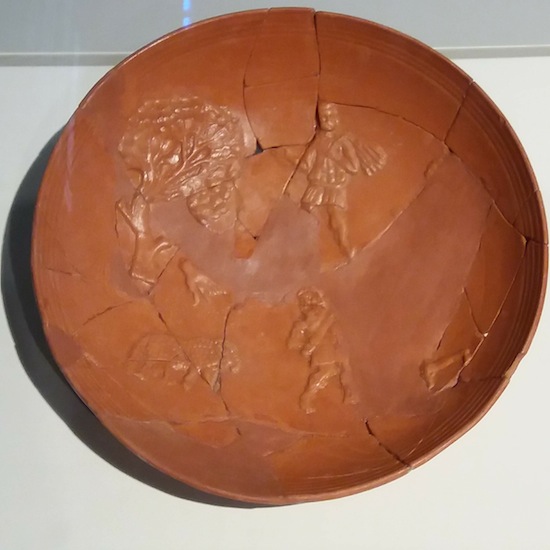
African red slip ware,
4th to 5th century AD, showing Abraham sacrificing Isaac
Fascinating, Sean. Although I knew recent dna evidence has confirmed Irish celts as being of Basque/Galician origin, I’d no idea the two cultures were so similar – as you probably know, our equivalent of the castro would be the ringfort. They’re dotted all over Ireland and are pretty much identical to your photos. The artefacts themselves wouldn’t be out of place in any Irish museum.
Did you get a chance to visit Castro de Baroña? It is one of the most amazing and inspiring places I have ever been in.
https://en.wikipedia.org/wiki/Castro_de_Baroña
Aonghus: The castros remind me of Pictish hilltop settlements in Scotland too!
Shadowphoenix: No, but it’s on the list!
The stone with the spirals is interesting, if you look on youtube there is a channel called megolithamania, they go to all the global sites including capadocia, they found some stones in Siberia and Ireland with the same design, these were discovered at ancient celtic sites. You should contact them with your artifacts, JJ Ainsworth was the name of the archaeologist. This design is also present in Sardinia. That stone links the Russian and British celts with Galatia in Turkey and the Galacia in Spainre is also dialect similarities with england and portugal words like shortinho and dancando, however these words do not appear across europe in this form, the galatian celts were nomads who travelled across europe wher as the other celts were clustered in france and remained largely stagnant to that region including german or germania due to the danube river and its fertility.
That stone head you have, it can be viewed in full at the Museos de Galacia https://museos.xunta.gal/en/viladonga/pezas-destacadas, this appears to be the generic design for depicting a head or face, it is conclusive with cave art in its standards and you should compare the cave paintings to it, the argument is that cave paintings are much younger and are in fact Celtic art. Celts preferred to live in caves, explaining why Cappadocia is the way it is, an architectural design of choice. Greeks in Phagia were allied to the celts yet the celts choose not to adopt there architecture and continue living this way. This is what all those underground bunkers are in main land Europe, the ones covered in grass hills, built in stone with soil grass mound on top. the celts were the cavemen that are suggested in archaeology. The spiral is a design used by the celts but also present in Sardinia with the Italians who become the romans. there are no celts in Sardinia these two did not get on. celts in Spain arrive after cartage. arguably why Portugal ultimately ends up being formed. the spirals in sardini indicate a previous culture across both peoples, Italian roman and the celts, they are from the same place which is Canaan. hence the pantheon of gods, that’s just a design of there.
If you compare this ” prehistoric art” discovered in france with what you have there you can see the similarities in the face and the spiral design. https://mythologyvault.com/symbols/artifacts/lascaux-cave-paintings-prehistoric-art/
Nuraghe have roots into canaan, later they become romans with canaanite pantheon but they have this already as nuraghe, this nuraghe is wearing a hittite helmet https://in.pinterest.com/pin/the-nuragic-bronze-called-the-libation-ca-6th-c-bce-found-in-a-nuraghe-near-lanusei-and-kept-at-the-museum-of-cagliari–354799276870539863/ and this pre viking is wearing the other type of nuraghe helmet indicating the horned helmet design is from canaan and the pre viking people in denmark are linked to the nuraghe who become the romans who are in fact italian. https://www.reddit.com/r/ArtefactPorn/comments/s0kfp7/horned_helmets_found_in_denmark_belong_to_the/
these are a demonstration of cultural assimilation across canaan in addition to tribal differentiation. so romans did not get the pantheon from greece. and romans were once assimilated with celts through spirals in nuraghe and celtic culture and pre vikings with this helmet.
So the caveman cave painting argument is based off that spiral and face design being used for 20, 000 years. Its evidently celtic, however cave art is more likely 3000 years old or roman times and the question is not how old is this cave painting but where did these people originate from?
My theory on the spiral, is that they believe it is a religious symbol, do you remember those posters with unusual coloured, patterned designs? From the 90? If you stared at them correctly a 3d shape would emerge? I think this is the same for them it has a theological grounding due to its presence in the stagnated french and the nomadic galtian, who travels the four corners of europe. The spiral connects them culturally despite geographic location and dialect differences. Also the galatians are christian at some stage in their travels, likely at cappadocia. from the Bible book “Galatians” not “Galacians”. Suggesting dispersal from Spain is possibly more than nomadic and a kind of pilgrimage. So these spirals remain despite the changes that occur whithin the celts, I think they stare at them to induce a type of hallucination or distorted vision like those 90s posters and they believe this is spiritual., you see in cartoons when a character hypnotises another the use the spiral that turns like in bus bunny. I thin that is what this is and why they find portable versions of it in the small carrying stones. large spirals on walls could be considered vultural art or desin however the portable ones suggest a deeper meaning, that they have the desire to suddenly stop and view a spiral. Its a vision distortment for spiritual purpose. Thats its theological connotation and underpinning reason for its continued and widespread use.
Theres is an explanation or scientific fact regarding staring at spirals, its called the spiral after effect, where it can change shape and direction, this is recognised in science, I think the nuraghe statue with the spirals under the eyes reinforces this point and I am looking for large spiral stones that are mounted and might turn, so maybe with a hole in the middle so it can be attached to a turning device.
look at new grange temple in ireland and see the spirals on the walls, meaning new grange is a theological temple, the christians took the spiral and turned it into the celtic knot to make it cultural design and from its original theological routes. it became decorative but its deeper than that, we know canaanite and celtic religoun uses types of hypnosis or trance states, or at least the desire to induce this, newgrange is not pagan its canaanite the term pagan is incorrect based off the nuraghe and their mass involvement with this ritual. so the caves in france are likely religious rooms, with food and hunting being intwined into there practise, stare at the spiral for food or good hunting staring at the spiral long enough will induce visual change in addition to mental state, motion sickness and balance could be effected as perception changes leading to changed mental state like thinking, the effect could span multiple areas of the mind and vision and balance etc making it a potentially full experience could be why they have this, staring at the spiral in a dark cave lit by fire
Due to illiteracy and the lack of interest or involvement in writing, ancient relgion was not based around truth or scripture but experience of physiological changes leading to mental perception changes, trance like states and physiological shifts including alteration to menatl perception was relgion in the ancient times and particulalrly at the core of the canaanite relgion in its early years, later scripture and mythology comes in with rome and greece and there was some in the form of ugaritic texts but the bulk of the illiterate population etc rely on this
There is a neurological science on these shapes and staring at them its studied in universities, altering depth perception, as the brain tries to correct these states it begins to focus narrowing the thought patterns and possible shutting dow other nervous systems responsible for hunger and heat interpretation, so the brain focuses on correcting the vision and hunger which is the vaga nerve i think and coldness disappear. So they are hunger stones to these people or weather stones thats why in the temples there is hunting surrounding them because they are used to deal with hunger a type os sensory confusion. sickness can be achiebved through vision impairments relieving hunger , dissines from shapes is better than spinning around in a circle as thats motion rather than confusing the brain through sensory perception, they are in malta too
Thats why nuraghe statues have the spirals under there eyes, because these ancient cultures were staring at them for prolonged periods to effect the optical nerve which is connect to the vargus nerve in the stomache to shut down hunger and force the brain to concentrate on correcting the optical nerve, these shapes are used in they celtic mantra chanting in dark caves by fire light staring at weird shapes to cause changes to the nervous systems resulting in the dissapearance or reduction in hunger, cold and andrenaline before war. this is why spirals survived and to say it is an basic design meaning the people who did it were primitive is wrong and then suggesting primitive means its 20 000 years old rather than 3000 years old is wrong. it is a threological symbol along with all the stuff in sardinia and malta its survived due to its purpose, the church sore this and realised the simplicity of the design was at its core, they were just staring at it, so the church turned it into a fancy celtic knot and put it on the cross and made it culture or artistic design the celts carried these untill christianity took over the church aloud them to continue viewing it but in a different context. simplicity does not suggest age or primitive peoples is just ignores its purpuse and value to the celts. and nuraghe and others in canaan, the canaanite pantheon changes agin with rome and greece when they create scripture and mythology and yet the celts continue with the older version of practise this is pagan practise, sitting in caves chanting by firelight and staring at weird shapes to create or alter sensory perception to relieve hunger and cold through the optical nerve disrupting the vagus nerve and confusing the brain and thats the core of pagan practise or celtic practise and what they did at newgrange sit and stared at spirals like the nuraghe giant statue
this is why the nuraghe monte prama statues are so tall, you stand under them and look up at the optical illusion in the eyes, should get and artist who specialises in that type of art to examine the dimensions of the face, including the height of the statue, the shadowing from the sun, the eybrow and how it pertrudes and the dimensions of the eyes. this is to examine the optical illusion capacity of the dimensions of the face due to its shape and why its weird shape and if its all purposesfully done this way to create the most optical illusion with regards to its dimesnions.
This optical illusion situation from the giants could be why the nuraghe statues of people all have such big eyes, because they worship through this optical illusion, the eyes of the people are different from the giants arent they? Also its appears the statues had over head covers to create light shadowing you should look at them, this light shadowing is about creating consistency in the lighting, the eyes on the statue dont match the quality of the carving of the head concerning dimensions etc do they, they are specifically weird and low down the face, i think due to the lack of knowledge back then concerning physiology they are under the power of suggestion largely as well as experience. more so that today
While I’m not disputing your theories, Mr. Clegg, I do feel that it’s important to point out another explanation of the wide-spread distribution of spirals seemingly across disparate cultures:
They’re easy.
To mark out a spiral to carve, anyone just has to wind some cordage evenly around a stick, stand the stick at the center of where the spiral is desired to be, hold some charcoal against the rock or piece of metal at the free end of the cordage, and start unwinding the cordage while maintaining tension and holding the charcoal against the drawing surface. As the charcoal makes the circular motion, the cordage comes freer at greater and greater lengths, and a spiral design naturally forms that the charcoal draws. After unwinding all of the cordage, all the artist has to do is start pecking along the path of the charcoal, to set the spiral into semi-permanance.
You could be right that the incidence of spirals traces branches of a peripatetic culture. But it’s unlikely that they were the only ones to discover spirals, given that spirals are so incredibly easy to create.